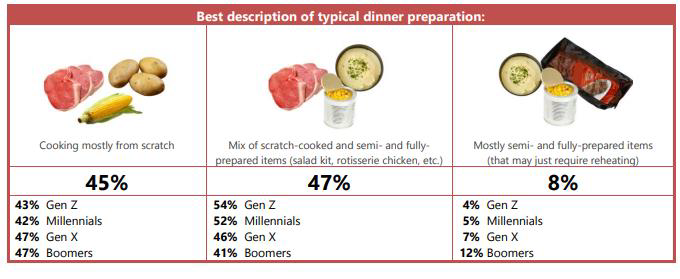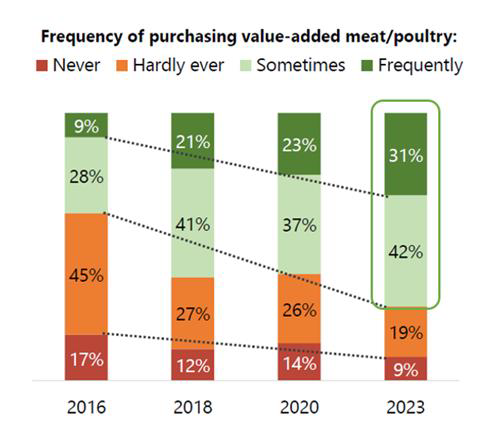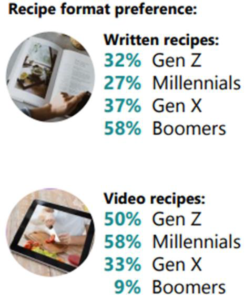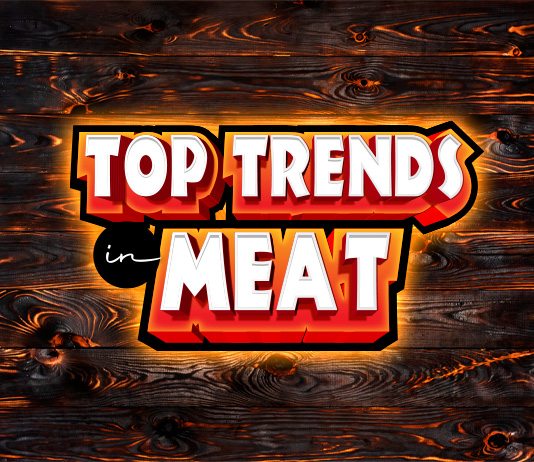Coming off another record year in total meat department sales, consumer shopping trends are rapidly changing as we shift from Baby Boomer-dominant spending to more Gen X/Millennials. With this shift, it is important to understand how to maintain and continue growth in the protein landscape. Let’s look at some of the trends that are happening as we are building sales leading into the back half of the year.
The meat department continues to lead in fresh perimeter sales with a 98.3% penetration of shoppers purchasing meat (fixed and random weight). Household penetration averaged above 97% for all incomes, ethnicities, household sizes and configurations and ages. Spending varies widely depending on household size and income. Gen X, the smallest of the generations, was the biggest contributor to meat sales in 2022, while Millennials accounted for the biggest increase in annual meat and poultry spending over 2022. Boomers shopped the most frequently in 2022, averaging 55 trips but spending less per visit versus their Millennial and Gen X counterparts.
Both pork and beef are struggling across dollars and volume while chicken is gaining share of fresh meat. Dollars spent of fresh chicken are up 7.1% year-over-year, while beef is down -3.2% and pork -4.2%. This can be attributed to the fact that shoppers are changing their shopping habits to save and stretch budgets with emphasis on the overall total package price. While volume and dollars are slightly down, beef is still accounting for 53% of all fresh meat dollars, more than all fresh proteins combined. Ground beef remained the biggest seller in the beef commodity. Packaged lunchmeat sales have jumped over dinner sausage due to year-on-year price increases of 19.4% per pound. Breakfast sausage maintained longer-term gains, hand-in-hand with strong frozen breakfast item sales.
About one-third of Americans are stressed for time when preparing dinner and/or are struggling to make ends meet. Time and money pressure is highest for Millennials, the generation most likely to have younger kids. Regardless of age, region, ethnicity, gender or income, semi- and fully-prepared items are becoming more and more popular — representing the majority of meals in either a lead or assistant role to items cooked from scratch.

In 2016, 37% of meat shoppers purchased value-added meat and poultry sometimes or frequently. In 2023, this increased to 67% — an increase of 30 percentage points. There are more frequent value-added meat buyers among all generations (except Boomers), families with kids, below average at-home meals, and people who have the lack of time.

Consumers are very aware of inflation and lack of promotions in food and meat/poultry. Inflation is driving many changes, including fewer restaurant visits and how much, where, and what type of groceries consumers purchase. Meat eaters are focused on buying only what they need and are looking for sales promotions, coupons, markdowns, and meal types that help stretch the meat dollar. Personal health, animal welfare, concern for the planet, and social responsibility affect the food and meat/poultry choices of many Americans who eat meat, fueling an interest in transparency. When buying meat/poultry, 62% are looking for products that are better for their health, and about one-third consider animal welfare, the planet and social responsibility. Healthy choices focus on leanness and portion control.
Opportunities
Consumers are relying on familiar, versatile cuts and they will welcome tips on how to save while bringing protein variety to the plate. Trip patterns are likely to change with Millennials and Gen X shopping less often but buying more per trip, favoring larger pack sizes, mixed protein offerings, and freezer-ready vacuum packaging with longer shelf life. With consumers aware of elevated prices and fewer promotions, the meat industry can provide savings hacks and price out the total meal as an example to point out the favorable cost of home-prepared meals over restaurant options. Some retailers have made a splash with price freezes, for everyday and seasonal items, while others highlight areas with deflation on shelf, in the ad, or on social media. With the important connection between in stock position and trip satisfaction, retailers can provide alternate recommendations in case of out-of-stocks and communicate the why.
Value
Shoppers prefer a variety of package sizes and prices. In fact, “buying only what I need” became the top money-saving measure and is one of the reasons behind the decline in volume sales in 2022. Creative promotions that cross-market meat with produce or different types of protein may prompt incremental purchases. Likewise, offering premium meat and poultry options, especially for holidays and special celebrations that have traditionally been food service-centric, recreating restaurant-type meals as an everyday meal opportunity, remain strong ways to connect with shoppers. With the importance of the meat department in store selection, building and maintaining a strong reputation is key to success for the total store through optimized primary shopper conversion and being a destination among secondary shoppers. While price is heavily emphasized in the current environment, educating shoppers on quality, freshness and available service can be ways to overcome price perceptions.
Convenience
Increased household penetration, more frequent purchases and larger baskets drove value-added sales growth that easily exceeded the total category performance for several of the proteins. The total category is up 1.1% in pounds versus 2019, the pre-pandemic baseline. As people are trying to create restaurant meals at home more frequently, utilizing some form of value-added protein has grown the category to almost $23 billion in annual sales.

Case Ready
Since 2008, meat consumers’ perception of case-ready meat has continued to grow more favorable. The share who believes case-ready is better than meat cut/packaged in the store has increased from 9% in 2008 to 32% in 2023. Meat shoppers with a negative quality perception are down from 38% in 2008 to 14% in 2023. The rising favorability is driven by younger generations, who are quickly gearing up their share of total meat spending. This is also a great way to combat out of stocks as retailers continue to struggle with labor challenges. Suppliers are offering several packaging types of case ready products. The leading packaging type offered at retail is now vacuum, representing 32% of packages in the Meat case, led by roll stock.
Claim-Based
Along with conventional, claims-based meat saw unprecedented growth rates in 2020. This was led by beef in both the organic and antibiotic-related claims areas. In 2021 and 2022, most areas kept up with 2020 sales in dollars due to inflation, but like their conventional counterparts, volume was a mixed story. Antibiotic-related claims performed best, with volume growth across proteins except for turkey. Organic drove volume gains for chicken and pork (with the latter being extremely small). Grass-fed was also a mixed story with ground beef performing better than average, but the total grass-fed sector trailing conventional. 85% of shoppers are looking for at least one better-for-you claim. This is driven by heavy social media users. This also fits in the higher income demographic, ages 35-48, with high likelihood of having kids in the household with heavy focus on health, portions and eating less. Another big contributor is the focus on claims, brands and convenience.

Technology and Social Media
With the adoption of technology by older generations, personalized offers can bring greater relevance to the shopper given the very different buying behavior across generations. Consider social media and other media platforms, products, attributes, messaging, promotional types, and price points for each unique audience. The meat industry has a great opportunity to expand its recipe repertoire with a variety of meat and poultry dishes. The key to success is meeting consumers at their point of inspiration and translating inspiration into purchases for the brand or store. Creating brand awareness through digital channels along with relevant advertising, are opportunities for meat visibility. Text messaging is also gaining traction as more opt-in discount programs are available. Shoppers are using more digital sources to help inspire and curate meal inspiration, led by recipe websites and YouTube. YouTube has emerged as the primary social media platform, well ahead of Facebook, TikTok, Instagram and Pinterest. The meat industry has a great opportunity to expand its recipe repertoire with a variety of meat and poultry dishes.











